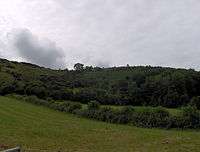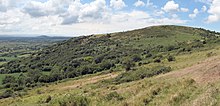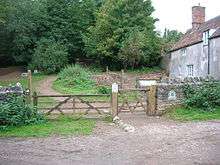Crook Peak to Shute Shelve Hill
Crook Peak to Shute Shelve Hill is a 332.2 hectare (820.9 acre) geological and biological Site of Special Scientific Interest near the western end of the Mendip Hills, Somerset. The line of hills runs for approximately 5 kilometres (3.1 mi) from west to east and includes: Crook Peak, Compton Hill, Wavering Down, Cross Plain and Shute Shelve Hill. Most of the site is owned by the National Trust who bought 725 acres (293 ha) in 1985,[1] and much of it has been designated as common land.[2] It was notified as an SSSI by Natural England in 1952.
| Site of Special Scientific Interest | |
 | |
 Location within Somerset | |
| Area of Search | Somerset |
|---|---|
| Grid reference | ST385555 to (grid reference ST430560) |
| Coordinates | 51.2952°N 2.8814°W |
| Interest | Biological and Geological |
| Area | 332.2 hectares (3.322 km2; 1.283 sq mi) |
| Notification | 1952 |
| Natural England website | |
The ecology of the area includes ancient woodland and calcareous grassland which supports nationally rare species including the Cheddar pink. The underlying rocks are Carboniferous Limestone containing phreatic caves at Shute Shelve Cavern and Picken's Hole from which fossils dating from the Middle Devensian have been recovered.
Description
The site extends for some 5 kilometres (3.1 mi) from west to east. Near its eastern end it is divided by a gap used by the A38 road and the disused Cheddar Valley railway line. At the western end of the hills, closest to the M5 motorway, is Crook Peak which reaches 191 metres (627 ft), and forms a prominent feature from the surrounding landscape.[3][4] Evidence of early human occupation of Crook Peak includes a polished flint axe.[5] It was used as the site of a beacon at the time of the Spanish Armada.[6] A ridge to the south east of Crook Peak, known as 'The Razor', is used by the West Mendip Soaring Association to fly model aircraft when the wind is a south-westerly, southerly or north-easterly direction.[7]

Compton Hill is above the village of Compton Bishop. Also within the parish of Compton Bishop is Wavering Down which reaches a height of 210 metres (690 ft),[8] and is marked with a triangulation station.[9] Around the small village of Cross is Wavering Down House which was, for the last 20 years of his life, the home of the British comedian Frankie Howerd.[10] The house is now a tourist attraction, and in the summer hosts concerts and opens regularly as a museum of Howerd's collection of memorabilia to raise fund for charities.[10] Above the village itself is Cross Plain where there are earthworks remaining from enclosures.[11] Further east is Shute Shelve Hill, east of the A38 road, reaching a height of 233 metres (764 ft), above the town of Axbridge and adjoining Axbridge Hill and Fry's Hill.
A long-distance footpath, the Mendip Way, follows much of the northern boundary of the site. There is also a 165 metres (541 ft) long tunnel which was part of the Cheddar Valley Line but is now used for pedestrians and cyclists.[12] Within the tunnel the central surface has been paved with tarmac but it is unlit except for a central guide line of small guide lamps. The north half of the tunnel is brick lined, but about midway it reverts to unlined rock for the southern half, marking a change in the underlying geology from sandstone to limestone.[13]
This is the best hill in Somerset!
Etymology
Crook Peak has been important as a landmark and boundary from very early times, and the origins of the name are unclear. The local parish council state that 'Crook' comes from the Old English 'Cruc' meaning 'peak' or 'pointed hill'.[14][15] 'Shute' is a contraction of schute which meant slope in the Middle Ages.[16]
Biological

This ecology of the site is varied. There are ancient and secondary semi-natural broadleaved woodland, however the majority is unimproved calcareous grassland with calcareous grassland and acidic dry dwarf-shrub heath.[17] Four of the calcareous grassland communities and two of the woodland types have a restricted distribution in Britain, as does the calcareous grassland/acidic dry dwarf-shrub heath. These support species, four of which are considered nationally rare while seven of the plant species present are considered notable. Plants of interest include the nationally rare Cheddar pink (Dianthus gratianopolitanus), bedstraw (Galium fleurotii), dwarf sedge (Carex humilis) and dwarf mouse-ear (Cerastium pumilum). Rose Wood and King's Wood are ancient woodland sites. King's Wood has coppiced hazel and nationally important small leaved lime.[18] The nationally rare purple gromwell (Lithospermum purpurocaeruleum) occurs at Rose Wood.[19]
Geological
Shute Shelve Hill, which is formed of Carboniferous Limestone laid down in the Dinantian period about 350 million years ago, rises to 233 metres (764 ft) above sea level. It is an anticline with younger limestones on the lower slopes.[20] Black Rock Limestone is exposed at several sites but is commonly covered by Burrington Oolite.[21]
Picken's Hole at the southern end of Crook Peak is considered to be of importance because of its clear, well-stratified sequence of deposits and faunas, all dating from within the Devensian. The cave is 8 metres (26 ft) below the plateau and 27 metres (89 ft) above the valley floor.[22] It is named after M.J. Picken who found teeth in earth thrown out of their sets in the area by badgers.[23] A large number of Middle Palaeolithic artefacts, and two Neanderthal teeth dated to about 55,000 years BP, have been recovered from the cave.[24][25][26] Faunal deposits of spotted hyena, lion, Arctic fox, mammoth, woolly rhinoceros, horse, reindeer, suslik and northern vole (Microtus oeconomus) from approximately 35,000 BP have also been recovered.[27]
Shute Shelve Cavern is located on Shute Shelve Hill. It is a natural cave system which was mined for its yellow ochre, until the 1920s.[28] The phreatic cave contains fossils of speleothems over 350,000 years old.[29]
Barton Camp
Barton Camp, which is on the northern slopes of Crook Peak, is run by the Bristol Children's Help Society which was founded in 1884 to help needy children. The centre provided residential activity courses. The facilities include classrooms, a sports hall, outdoor pool, playing field and bunkhouse accommodation.[30][31]
References
| Wikimedia Commons has media related to Crook Peak to Shute Shelve Hill. |
- "Trust fundraising push reached new heights". Western Daily Press. 9 September 2010. Archived from the original on 26 April 2015. Retrieved 26 April 2015.
- "Crooks Peak and Compton Bishop Hill". Common Land in England. Retrieved 26 April 2015.
- "Crook Peak". Good run guide. Retrieved 26 April 2015.
- "Crook Peak". UK Climbing. Retrieved 26 April 2015.
- "Winscombe Parish — A more detailed history. Early Settlement". Winscombe and Sandford Parish Council. Archived from the original on 24 May 2015. Retrieved 26 April 2015.
- Dommett, Pete. "Crook Peak, Mendip Hills". Countryfile. BBC. Retrieved 26 April 2015.
- "Our location". West Mendip Soaring Association. Retrieved 21 April 2015.
- Roberts, James (1997). Walking in Somerset. Cicerone Press. pp. 102–106. ISBN 978-1-85284-253-6.
- "TP6778 - Wavering Down". Trig Pointing UK. Retrieved 26 April 2015.
- Smith, Stephen (17 March 2007). "Titter ye not — it's Frankie's pad". BBC. Retrieved 16 October 2007.
- "Enclosures, Kings Wood, Compton Bishop". Somerset County Council. Retrieved 26 April 2015.
- "Exploring the Strawberry Line". Strawberry Line. Retrieved 26 April 2015.
- "Exploring the Strawberry Line". The Strawberry Line. Retrieved 22 April 2015.
- "Winscombe Parish". Archived from the original on 24 May 2015. Retrieved 7 October 2010.
- "Not a soul in the West Mendips". Times Online. London. 25 March 2006. Retrieved 18 July 2006.
- Costen, Michael D.; Aston, Mick A. (2008). "An early medieval secular and ecclesiastical estate: the origins of the parish of Winscombe, North Somerset" (PDF). Somerset Archaeology and Natural History. 151: 139–158. Archived from the original (PDF) on 19 August 2017. Retrieved 26 April 2015.
- "Landscape Assessment of the Mendip Hills". Mendip AONB. Archived from the original on 4 March 2016. Retrieved 22 April 2015.
- "Village Design Statement The Parish of Compton Bishop" (PDF). Compton Bishop. p. 3. Retrieved 26 April 2015.
- "Crook Peak to Shute Shelve Hill" (PDF). English Nature. Archived from the original (PDF) on 13 October 2006. Retrieved 17 July 2006.
- Haslett, Simon K. (2010). Somerset Landscapes: Geology and landforms. Usk: Blackbarn Books. pp. 38–41. ISBN 978-1-4564-1631-7.
- "Crook Peak and Axbridge". British Geological Survey. Retrieved 22 April 2015.
- "Picken's Hole (Scragg's Hole), near White Rock, Compton Bishop". Somerset Historic Environment Record. Somerset County Council. Retrieved 26 April 2015.
- Tratman, E.K. (1964). "Picken's Hole, Crook Peak, Somerset: A Pleistocene Site" (PDF). Proceedings of the University of Bristol Spelaeological Society. 10 (2): 112–115.
- "Picken's Hole". National Heritage List for England. Historic England.
- Pettitt, Paul; White, Mark (2012). The British Palaeolithic: Human Societies at the Edge of the Pleistocene World. Abingdon, UK: Routledge. pp. 364–65. ISBN 978-0-415-67455-3.
- Smith, David Ingle (1975). Limestone and Caves of the Mendip Hills. David & Charles. pp. 360–361. ISBN 978-0-7153-6572-4.
- "Crook Peak to Shute Shelve Hill SSSI citation sheet" (PDF). English Nature. Archived from the original (PDF) on 3 March 2016. Retrieved 26 April 2015.
- "Crook Peak and Axbridge". British Geological Survey. Retrieved 7 July 2009.
- Farrant, A.R.; Gray, A. (1993). "Shute Shelve Cavern. Exploration, History and Geomorphology" (PDF). Proceedings of the University of Bristol Spelaeology Society. 3: 283–290.
- "Barton Camp". The Bristol Children's Help Society. Retrieved 21 April 2015.
- Steve Eggington (August 2006). "Serious Playtime". Mendip Times. 2 (3): 10–11.